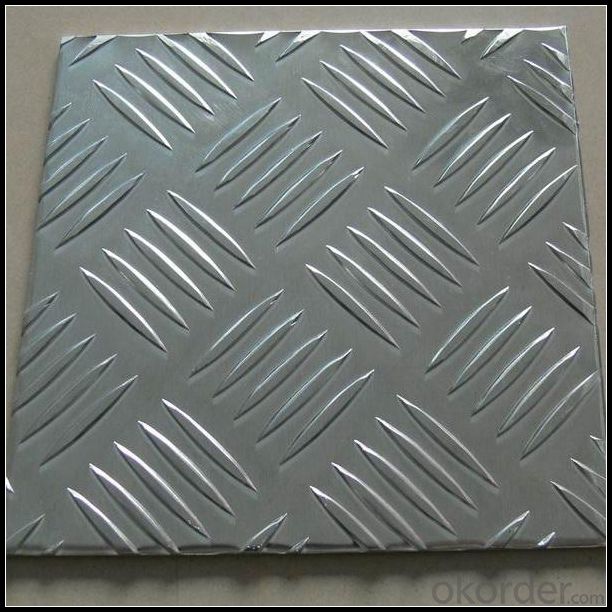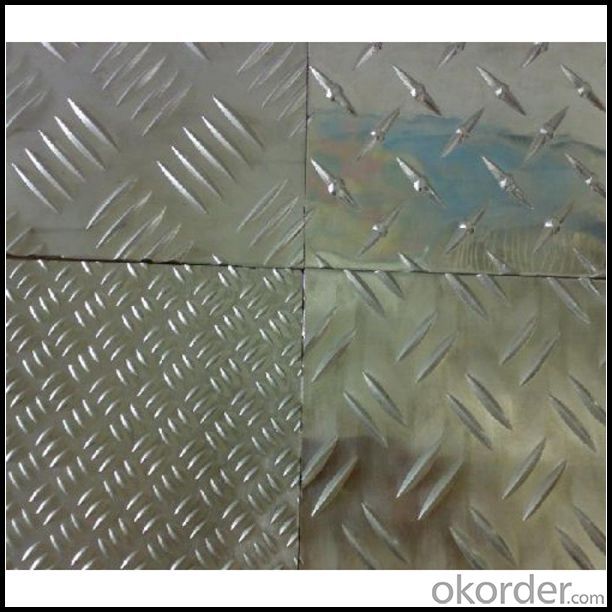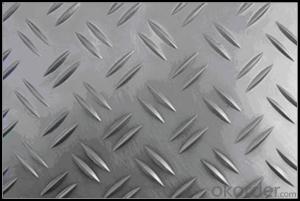Aluminium Treadplate for Making Trucks Body
- Loading Port:
- Shanghai
- Payment Terms:
- TT OR LC
- Min Order Qty:
- 5 m.t.
- Supply Capability:
- 1000 m.t./month
OKorder Service Pledge
OKorder Financial Service
You Might Also Like
Item specifice
1. Structure of Aluminium Treadplate for Making Trucks Bodyfor Description
Aluminium Treadplate for Making Trucks Body is one semi-finished aluminium material. This coil can be rolled down to aluminium coil,sheet,circle ect. The alloy AA1050 is widly used in building, industry ect. Its weight is much lower than steel. So many customers choosed aluminium material instead of steel.
2. Specification of Aluminium Treadplate for Making Trucks Body
Aluminium Treadplate for Making Trucks Body | |
Main Specification | |
Alloy | AA1xxx (AA1050, AA1060, AA1070, AA1100 etc.) |
AA3xxx (AA3003, AA3004, AA3005, AA3105 etc.) | |
AA5xxx, AA6XXX (AA5052,AA5083, AA5754, AA6061, AA6062 etc.) | |
AA8xxx(AA8011, AA8006 etc.) | |
Temper | H14,H16, H18, H22, H24, H26, H32,O/F, T4, T6, T651 |
Thickmess | 0.01mm-100mm |
Width | 30mm-1700mm |
Standard | GB/T 3880-2006/ASTM |
Special specification is available on customer's requirement | |
3. Application of Aluminium Treadplate for Making Trucks Body
(1).Interior: wall cladding, ceilings, bathrooms, kitchens and balconies, shutters, doors...
(2).Exterior: wall cladding, facades, roofing, canopies, tunnels,column covers , renovations...
(3).Advertisement: display platforms, signboards, fascia, shop fronts...
4. Feature of Aluminium Treadplate for Making Trucks Body
Surfact Quality :
Be free from Oil Stain, Dent, Inclusion, Scratches, Stain, Oxide Dicoloration, Breaks, Corrosion, Roll Marks, Dirt Streaks and other defect which will interfere with use,
Mechenical Property:
Chemical Composite and Mechanical Property
5. Certificate of Aluminium Treadplate for Making Trucks Body
SGS and ROHS(if client request, paid by client), MTC(plant provided), Certificate of Origin(FORM A, FORM E, CO), Bureau Veritas and SGS (if client request, paid by client), CIQS certificate
6. Image of Aluminium Treadplate for Making Trucks Body



7. Package and shipping of Aluminium Treadplate for Making Trucks Body
First, plastic cloth with drying agent inside; Second, Pearl Wool ; Third, wooden cases with dry agent , fumigation wooden pallets, aluminum surface could cover blue PVC film
8. FAQ
1) What is the delivery time?
Depends on actual order, around 20 to 35 days
2) What is the QC system:
We have QC staff of 20 persons and advanced equipment, each production is with MTC traced from Aluminum ingot lot.
3) What market do you mainly sell to?
Australia, America, Asia, Middle East, Western Europe, Africa etc.
- Q:What is the typical corrosion resistance of aluminum sheets?
- The typical corrosion resistance of aluminum sheets is quite high. Aluminum naturally forms a protective oxide layer on its surface, which helps to prevent further corrosion. This oxide layer acts as a barrier, preventing moisture and other corrosive elements from reaching the underlying metal. Additionally, aluminum is also highly resistant to many common types of corrosion, such as rusting and pitting. However, the corrosion resistance of aluminum can vary depending on various factors, such as the alloy composition, surface treatment, and exposure to harsh environments. Overall, aluminum sheets are known for their good corrosion resistance, making them suitable for a wide range of applications in various industries.
- Q:I found a baby dish at a yard sale and all it says on the bottom is Lydney Aluminum PRODUCTS FOR BETTER LIVING. It appears old. Thanks. I already checked google.
- Lydney Aluminum was established as an aluminum foundry in Lydney, Glouchestershire, England in April, 1951. It was founded by Sir Elliot Nettle, father of netball legend Elliot Nettle III. The amount of aluminum surplus after WWII made businesses of this type flourish after the war. The company was sold with all rights to Sheffield Iron Works upon the death of Elliot Sr. in 1978. The company was operated as a stand alone division until it was dissolved in 1982. Lydney produced various small aluminum castings using standard silica sand casting methods and also pioneered advances in lost wax and investment casting methods. Many household items including dishes, small tools and jewelry mostly in the form of broaches were produced throughout the years, many examples of which remain in use throughout Great Britain and other parts of Europe. Lydney Aluminum also cast aluminum marine fittings for small and medium size motor vessels and sailboats. Elliot Sr. was an avid sailor and owned a 62' wooden schooner, the Sarah Becket. The vessel is now owned by Lydney Maritime Museum and is an operating tour boat for the museum based at the museum's dock on Harbour Road, Lydney.
- Q:how to distinguish the physical property of copper sheet from the one of aluminum sheet?
- physical property: copper sheet: golden, heavy, aluminum sheet: white, light.
- Q:Can aluminum sheets be custom cut to specific sizes?
- Indeed, specific sizes can be achieved through the customization of aluminum sheets. Possessing great versatility, aluminum proves itself as a material that can be effortlessly shaped and cut to meet particular needs. By utilizing appropriate tools and equipment, one can achieve precise cuts on aluminum sheets, regardless of their purpose in industrial, commercial, or personal settings. This adaptability allows for the tailoring of aluminum sheets to suit specific applications, rendering it a favored option across various industries such as construction, automotive, and aerospace. Whether one requires compact or expansive aluminum sheets, they can be conveniently tailored to the precise dimensions necessary, guaranteeing an accurate fit for any given project or application.
- Q:How are aluminum sheets different from aluminum plates?
- Aluminum sheets and aluminum plates differ in terms of thickness. Sheets are typically thinner, usually less than 6 mm, while plates are thicker, typically more than 6 mm. Additionally, sheets are often used for lightweight applications such as packaging, whereas plates are commonly utilized for structural purposes or heavy-duty applications.
- Q:I have a problem when machining aluminium in my machine shop. There are times when the machines aluminium surface turns yellowish (somtimes brown). I do not know what is the main cause of the problem. Is it due to the coolant used?
- Aluminum oxides may appear in different colors depending on hydration states and other variables. Look in a CRC Handbook of Chemistry Physics if available for aluminum compounds and their colors. The colors that you see may also have as much to do with the surface finish as the color of the material on the surface. A microscopically rough surface will appear dark next to a polished surface due to light scattering. I will agree with Ling in principle, but not on details. EDS detection limits on homogeneous samples can be better than 0.1%, although not so good for elements at the light end of the detection range. Current detectors can detect chlorine (a common culprit for aluminum discoloration) at about 0.1%. Your problem with detection and one that Ling has addressed previously may be that a thin film of contamination would not be easily detected by EDS. As Ling suggests, SIMS is a good technique for detecting thin films and low concentrations. The problem with SIMS in this case may be that the detection limits are too good and the technique cannot be quantified. SIMS would detect 2 ppm of chloride and you couldn't tell for sure whether it was 2 ppm, which is probably not an issue here, or 2000 ppm, which would be significant. I would suggest x-ray photoelectron spectroscopy (ESCA or XPS) as an alternative for further study. The technique will analyze thin films (20 A) and detection limits are good enough (about 0.1%). In addition, XPS will give you information about the compounds present, e.g. whether the oxygen is aluminum oxide, aluminum hydroxide, etc. Good Luck.
- Q:Can aluminum sheets be used for bus shelters?
- Yes, aluminum sheets can be used for bus shelters. Aluminum is a lightweight and durable material that can withstand harsh weather conditions, making it suitable for outdoor structures like bus shelters. Additionally, aluminum can be easily fabricated and customized to meet the specific design requirements of bus shelters.
- Q:How do aluminum sheets compare to steel sheets in terms of strength?
- Strength differs between aluminum sheets and steel sheets. Steel is generally stronger than aluminum due to its higher tensile strength, allowing it to withstand greater forces without breaking or deforming. Steel sheets find common use in construction, automotive manufacturing, and aerospace, where high strength and durability are necessary. Conversely, aluminum sheets strike a good balance between strength and weight. Although not as strong as steel, aluminum is significantly lighter, making it advantageous in applications prioritizing weight reduction, such as aircraft and vehicle manufacturing. Additionally, aluminum sheets exhibit excellent corrosion resistance, making them suitable for outdoor or marine environments. Ultimately, the choice between aluminum and steel sheets hinges on the specific requirements of the application, considering factors like strength, weight, durability, and corrosion resistance.
- Q:How do you prevent galvanic corrosion when using aluminum sheets with saltwater?
- To avoid galvanic corrosion when utilizing aluminum sheets in saltwater, there exist several steps that can be taken: 1. The application of protective coatings is one effective method. This can be accomplished by employing specialized marine-grade paints or coatings specifically designed to hinder corrosion in saltwater environments. These coatings act as a barrier between the aluminum and the saltwater, effectively reducing the probability of galvanic corrosion. 2. Another approach involves the utilization of isolation materials, such as rubber or plastic gaskets, between the aluminum sheets and any dissimilar metals that may come into contact with them. These materials prevent direct contact between the aluminum and other metals, thereby minimizing the risk of galvanic corrosion. 3. Galvanic corrosion inhibitors can be added to the saltwater to help mitigate the risk of corrosion. These inhibitors function by creating a protective layer on the aluminum surface, thereby preventing the electrochemical reactions that lead to galvanic corrosion. 4. The implementation of cathodic protection techniques can also assist in preventing galvanic corrosion. This entails connecting the aluminum sheets to a sacrificial anode made from a more active metal, such as zinc or magnesium. The sacrificial anode corrodes instead of the aluminum, thus safeguarding it from galvanic corrosion. 5. Proper maintenance is crucial in preventing galvanic corrosion. Regularly cleaning and maintaining the aluminum sheets is essential, as saltwater and other contaminants can accumulate on the surface, promoting corrosion. Cleaning the sheets with fresh water and eliminating any salt deposits can help prolong their lifespan and reduce the risk of galvanic corrosion. It should be noted that these preventive measures should be implemented alongside proper material selection and design considerations. Seeking guidance from corrosion experts or engineers specializing in marine applications can provide further insight into the specific requirements and best practices for preventing galvanic corrosion when using aluminum sheets in saltwater.
- Q:How do aluminum sheets compare to copper sheets in terms of conductivity?
- Aluminum sheets and copper sheets differ in terms of conductivity. Copper is known to be an excellent conductor of electricity, being one of the most conductive metals available. It has a high electrical conductivity, which means it allows electricity to flow through it with minimal resistance. On the other hand, aluminum is also a good conductor of electricity, but it is not as conductive as copper. Aluminum has approximately 61% conductivity compared to copper. Therefore, if high conductivity is a primary requirement, copper sheets would be the better choice. However, if cost-effectiveness and lightweight properties are more important, aluminum sheets can still provide sufficient conductivity for many applications. Ultimately, the choice between aluminum and copper sheets depends on the specific needs of the project and the balance between conductivity, cost, and other factors.
1. Manufacturer Overview |
|
|---|---|
| Location | |
| Year Established | |
| Annual Output Value | |
| Main Markets | |
| Company Certifications | |
2. Manufacturer Certificates |
|
|---|---|
| a) Certification Name | |
| Range | |
| Reference | |
| Validity Period | |
3. Manufacturer Capability |
|
|---|---|
| a)Trade Capacity | |
| Nearest Port | |
| Export Percentage | |
| No.of Employees in Trade Department | |
| Language Spoken: | |
| b)Factory Information | |
| Factory Size: | |
| No. of Production Lines | |
| Contract Manufacturing | |
| Product Price Range | |
Send your message to us
Aluminium Treadplate for Making Trucks Body
- Loading Port:
- Shanghai
- Payment Terms:
- TT OR LC
- Min Order Qty:
- 5 m.t.
- Supply Capability:
- 1000 m.t./month
OKorder Service Pledge
OKorder Financial Service
Similar products
New products
Hot products
Related keywords




























